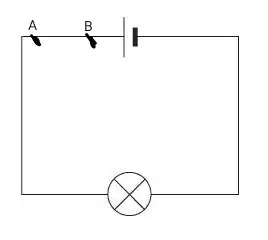We know that at point A and B there is same voltage.Then why electron moves from one point to the another one?
- 315
6 Answers
For the same reason an object can theoretically slide at constant velocity on a surface having zero friction without the application of a force, electrons can theoretically flow between points A and B without a voltage between A and B if there is zero resistance between the points. The electrical resistance is analogous to the mechanical friction.
However, in the real world there is no such thing as zero friction and no such thing as zero resistance (an exception being low temperature super conductors). In electrical circuit diagrams the wires connecting electrical components are assumed to have resistance so much less than the components that it can be ignored so that there are no voltage differences along the wires.
Then velocity of electron will become less after passing through a resistor?
No, and that is a common misconception.
The current in a resistor (rate of charge transport across any cross sectional area of the resistor) is the same throughout the resistor. The electrons do not slow down on average as they move through the resistor. If less electrons per unit time exit the resistor than enter it, electrons would pile up in the resistor, which doesn't happen. However, for a given voltage between two points, the greater the resistance between the points, lower the current (the slower all the electrons will move through the resistor).
The reason why the electrons don't slow down in the resistor is that the kinetic energy they lose in collisions with the atoms and molecules of the resistor as heat is continuously replenished by the work done by the force of the electric field applied to the resistor, so that the average kinetic energy of the electrons remains constant (the average drift velocity of the electrons remains constant). A mechanical analogy is pushing an object at constant velocity on a surface with friction.
Hope this helps.
- 81,786
"We know that [at] point A and B there is same voltage." There isn't. There will be enough of a voltage difference between A and B to drive a current through the wire. The resistance of the wire between A and B is, we assume, very low, so only a very small voltage difference will be needed.
- 37,325
I'm afraid this is like asking "if the river is level, why does the water move?" Because the water is under pressure.
Voltage is akin to pressure. The point of confusion arises because you're ignoring the fact that the battery is creating "pressure" (a potential difference). And what you're asking is, "why does the water in the river have the same pressure at two points along its length?"
Perhaps what you've forgotten is that you can't actually measure voltage at one point. It must be measured against a reference point. You've forgotten that the potential difference between two arbitrary points on a wire and "ground" is the same. From a very simplistic perspective, it's the "ground" reference (or a bit more accurately, the voltage potential between the reference and the test point) that's making the electron move.
- 158
If you pump water through a frictionless pipe, why does the water move? It moves because there is water pushing it from the pump. This force is transferred from one molecule to the next. The force between water molecules "wants" to average out, therefore the whole body of water must move. Electrons repel each other. If you force electrons into one end of a wire and there is somewhere for them to go, then, by keeping the mean distance between each other constant (by electrostatic repulsion), they must move to the current sink. Imagine a series of compression springs attached end-to-end. Push at one end and they all move even if the measured pressure is the same between any two.
In fact, this is why a solid moves if you push at one end. You are compressing zillions of tiny springs and, in the absence of friction, this pressure will even-out along the length of the solid.
- 3,026
in an ideal wire, $R_{ab} $ is $0$, so the electrons will have zero resistance, and their direction moving won't change.
- 109
- 2